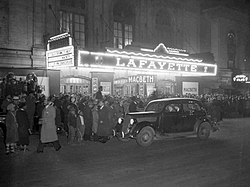Lafayette Theatre (Harlem)

Opening of Macbeth (April 14, 1936)
|
|
| Address | 2225 Seventh Avenue New York City, New York United States |
|---|---|
| Construction | |
| Opened | 1912 |
| Demolished | 2013 |
| Years active | 1912–1951 |
| Architect | Victor Hugo Koehler |
The Lafayette Theatre was an entertainment venue located at 132nd Street and 7th Avenue in Harlem, New York that operated from 1912 to 1951. The structure was demolished in 2013.
The Lafayette Theatre, known locally as "the House Beautiful", was one the most famous theaters is Harlem. Located at 132nd Street and 7th Avenue, the 1,500-seat two-story theater was built by banker Meyer Jarmulowsky. It was designed in the Renaissance style by architect Victor Hugo Koehler, who also designed the two three-story buildings flanking the theater on the corners of 131st and 132nd Streets. The Lafayette Theatre opened in November 1912.
In 1913 the Lafayette became the first major theater to desegregate.African-American theatergoers were allowed to sit in orchestra seats instead of the balcony, to which they were relegated in other New York theaters. The Lafayette Players, the resident stock company, played before almost exclusively African-American audiences both in plays from white theater repertory and in the classics. The theater and presented such Broadway hits as Madame X and Dr. Jekyll and Mr. Hyde. From 1916–1919, the theatre was managed by Quality Amusement. Robert Levy, the owner of this entertainment company, drew large audiences of both blacks and whites with his sophisticated productions and groundbreaking work with black actors.
In 1923, Duke Ellington made his New York debut while performing in Wilbur Sweatman's band at the Lafayette, and later performed with his own group at the venue. This was all due to producer/director Leonard Harper who Ellington lived with as a boarder in his larger Harlem apartment at the time. Other jazz musicians who performed at the Lafayette include Fletcher Henderson, Bennie Moten, Chick Webb, and Zutty Singleton.
...
Wikipedia
